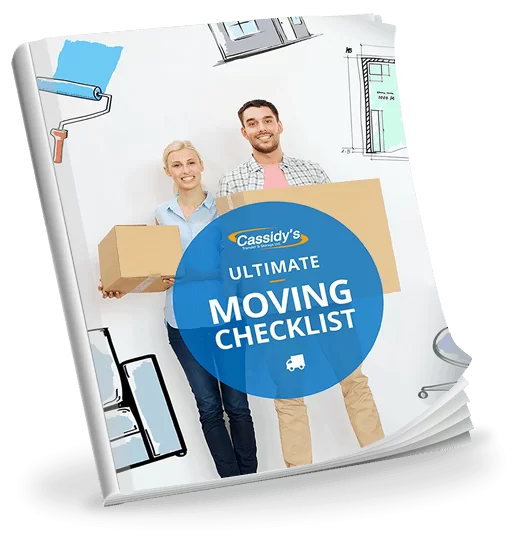When looking for a new home, you’ll need to decide whether your new Ottawa neighborhood will suit your needs and lifestyle. Choosing the right neighborhood is just as important as choosing the house itself; you’ll need to consider property value ranges, property types, and proximity to schools and other amenities along with various other factors.
So, how do you select the best neighborhood? Here are some basic tips from our Clarence-Rockland moving company for choosing the best place to buy a new home.
1. Are You Moving Local Or Long Distance?
You may already live in the Ottawa region and are looking to make a local Ottawa move to a new neighborhood, or you may be coming from the east or west coast—either way, moving to a new home and a new neighborhood is a huge undertaking! This may be decided for you based on a new job or a new school, but deciding how long you want your commute will help you set your ideal neighborhoods.

Free Ultimate Moving Checklist
Say goodbye to moving stress with our 2023 residential moving checklist for Canada—it’s the ultimate time-saver!
Download NowIf you’re moving internationally, be sure to check what you need from a legal standpoint in order to immigrate to Canada without issues, and research your international moving options to understand what is attainable for you.
2. Do You Prefer The City, Rural Or Suburbs?
Each has its pros and cons—do you like having neighbors? Do you want to be within walking distance of all amenities? Deciding what your ideal setting will be can tell you the best area for you.
Open space, big yards, and quiet in a rural area means there are typically fewer options for stores, a spread-out school district, and community resources. Living in the city means lots of options for entertainment and schools as well as activities and community programs, but it does mean less space, neighbors close by and typically noisy traffic.
The suburbs can be an “in-between” of the two, and it’s up to you to evaluate what you prefer. Changing your neighborhood can be a big adjustment so make sure your expectations are reasonable and educated.
3. Safety and Crime Statistics
Do some research on crime statistics in your chosen neighborhood. This information can usually be found on the Internet, however, only limited information may be available for smaller towns. Another good idea is to contact the neighborhood’s local police department. Suppose the neighborhood is at all interested in crime prevention. In that case, the police should be able to provide information on how active community policing is and have crime reports available to you.
Crime stats can also have an effect on your home and car insurance, so they are an important factor to consider. Finally, take a drive through the area and take note of places where there is a lot of vandalism or graffiti. Check to see if homes in the area have crime deterrents like high fences, bars on windows, or “Beware of Dog” signs.
4. Neighborhood Appearance and Feel
Take some time to walk around the neighborhood and see how well it’s maintained. Do houses in the area have nice yards and driveways? Note whether the streets and sidewalks are clean, and look for vacant properties or abandoned lots. These could one day be used for commercial purposes, which could change the look and feel of the neighborhood.
Commercial developments can also affect property values. If you can’t visit but still want to get a good feel, using Google Street View can be an effective tool for taking a virtual “stroll”. The right neighborhood means the best neighborhood for you—it’s relative to your needs.
Emerging neighborhoods typically mean investing in open spaces, a bigger grocery store with more selection and lower crime rates. Ideally, in a few years, your new home will be in an older neighborhood—and a single-family home in established neighborhoods can mean a huge return on investment if you pay attention.
5. Proximity to Shopping & Restaurants
Go back to the list you made earlier, and check to see that the amenities you need are available in your chosen neighborhood. If you need to make frequent trips to convenience and grocery stores, restaurants, and shops, you’ll want to ensure these amenities are nearby.
If there are bars and clubs in the neighborhood, consider how noisy they may be on the weekends. How involved is the local chamber of commerce? It is an essential indicator in knowing if the neighborhood will grow and attract local businesses.
6. Schools
A well-maintained local school district is the sign of a desirable neighborhood. If you have school aged children, think about how long it will take them to get to school every day. Can they walk, or will they need to take public transportation? Is the trip safe? How long does it take to drive to the school? If you want children in the future, are there reputable daycare centers nearby?
The local school district may have rules on which schools you can attend based on your address. You may also want to look for neighborhoods with other young families in that particular area- a real estate agent will know that kind of information.
7. Home Values and Property Taxes
Research current property values in the neighborhoods, and compare them with the average prices five and ten years earlier on real estate websites. Note how much property values have increased and whether the neighborhood has undergone any major changes in that time. Next, find out if the neighborhood has plans for further development. You can find this information through city hall or the neighborhood Chamber of Commerce.
Future developments could affect property taxes and road traffic, so it’s a good idea to know if and when there will be changes in the area. This will indicate if you are making a sound investment and can expect your property value to go up in your new home.
8. Property Type
While trying to choose the right neighborhood is important, a large part of where you live will be dictated by the type of home you want. High-rise condominium apartments will be harder to find in the suburbs than in the city, as will single-family homes with large yards in the heart of the city.
With multi-generational homes becoming more popular, you might consider a planned community with access to pools, tennis courts, and clubhouses. Choosing your new home in the right neighborhood will have a massive impact on your quality of life.
9. Parks for Kids & Pets
Community programs such as safe parks for children or pets indicate the type of neighborhood you are moving into. If all that is in the park is garbage everywhere and two broken swings, you know that it isn’t maintained and it most likely isn’t a very child-friendly neighborhood.
This may not matter if you have a large rural property with space to put your own swing set, but living in the city you may want to have a space for your children or pets to have fun, make friends, and burn some energy! A well-maintained green space is an excellent indication of the health of the community.
10. Proximity to Work
This point is very important. When testing the time it takes to get to work from a neighborhood you’re interested in—make sure you’re checking at rush hour. If you’re checking the commute after dinner, you’re not going to get a full picture of how traffic is. You may also want to keep in mind the weather- If you’re getting a rural property, your road will not be plowed first after a snowstorm.
Do you have more than one way to get to work? While many companies have implemented a hybrid model, you may need to have more than one way to get to work in case you don’t have your car. Is there public transportation? How reliable is it? Do the schedules match up with your work hours?
11. Explore the Neighborhood
This one is the most important. If you can, rent an Airbnb for a night or two in the neighborhood you want and see how you like it. We suggest a Thursday and Friday night- this lets you get a feel for both weekday and weekend life in the traffic, noise levels, and how easy it is to get your errands done (and what restaurants are good in the area!).
If that isn’t an option, simply going for a drive or taking a walk a few times on different days will also help give you a good picture. Finally, go to your local coffee shop and talk to the barista—not only do they know the patterns of the population throughout the week, but they will also typically have valuable insight on the neighborhood, the local culture, and some tips on the best places around.
Just make sure they’re not busy with a lineup behind you!
Get Moving With Cassidy’s
You’ll also be able to reach out to a real estate agent to help you find a home that checks off all your boxes- and can help you narrow down your neighborhood list by offering local insight and will help you choose the right neighborhood.
Once you’ve found your ideal neighborhood, trusting the professionals with your moving will help make the transition go smoothly from planning to execution.

